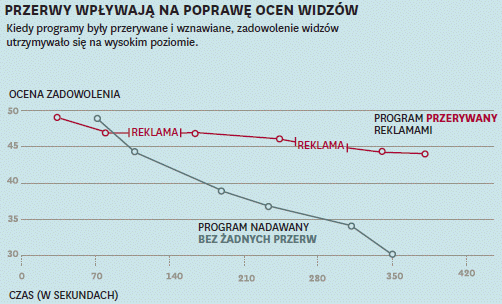According to Harvard Business Review Polska, which published the study, two test groups were shown three types of programs:
- episodes of the comedy series *Taxi*,
- documentary nature films,
- and Bollywood productions.
One group watched the programs without ads, while the other saw them with ad interruptions. The results were surprising: the group that saw the shows with ads was more satisfied with the programs, regardless of the quality of the ads shown.
 source: Harvard Business Review Polska, Why Do We Prefer TV with Ads?
source: Harvard Business Review Polska, Why Do We Prefer TV with Ads?Surprisingly, viewers who watched the version with ads were also willing to pay more for DVD sets of productions by the same directors. The study published by Harvard Business Review Polska found that this difference could be as much as 30%.
- viewers of the ad-free version offered $4.18 for a DVD
- viewers of the ad-supported version were willing to pay up to $5.42 for the same DVD.
The study authors note that this principle is reflected in pay TV, even though it doesn’t include ads. These networks structure their programming with built-in breaks.
- What increases viewer enjoyment isn’t the ads themselves but the breaks in the show, - explains Prof. Leif Nelson in an interview with HBRP. - In series, the plot usually consists of six or more parallel storylines that producers continuously juggle. More complex and unpredictable shows, with twists that naturally introduce breaks, were rated higher than programs with a more linear narrative structure.
This is known as the adaptation effect. The researchers found that this effect is much stronger among younger people. As people age, they need less stimulation to feel pleasure and adapt more slowly.
Nelson, Meyvis, and Galak`s research was also published in the Harvard Business Review Polska special report Why Do We Prefer TV with Ads?
COMMERCIAL BREAK
New articles in section Marketing and PR
#POMAGAM2026 Can a New Year's resolution go viral?
wspieramy
Is a million good deeds a lot? Ten-year-old Emilka wants to find out. She just announced the I Resolve to Help campaign on the internet and urges everyone to make a unique New Year's resolution. That we help each other more often in 2026.
Dance in the media mirror. Between culture, business and viral fame
KFi
Over 78,000 media pieces, 1.6 billion potential views, and 197,500 social media mentions-dance in Poland is no longer niche. With a combined media value exceeding PLN 800 million, it now outperforms MMA, handball, and hockey.
PR in Poland. Ranking of the largest public relations agencies 2025
KFi
The smallest teams often generate the most publications, and agencies outside Warsaw are increasingly capturing media attention. This unexpected distribution of power is one of the key findings from the 2025 PR Agency Ranking in Poland, developed by Widoczni and IMM.
See articles on a similar topic:
7 facts about media relations. How to work with journalists
Bartłomiej Dwornik
In media relations, every mistake costs you attention. Every cliché wastes inbox space. Even a good and interesting topic might not be enough to break through. The way you present it also matters. Maybe even more than the content itself.
SEO and AI in Polish e-commerce 2025. Harbingers analysts’ report
Krzysztof Fiedorek
Although 44.56% of e-commerce traffic comes from organic results, over half of online stores are not seeing growth. The biggest surprise? A staggering 9.5 million monthly visits lost due to dead content. On top of that, 38% of companies still don’t appear in AI-generated answers - a new and growing source of visibility.
Connected TV and borderless advertising. The ID5 report
KFi
Viewers are moving away from cable TV. And they are doing it en masse. Already 86% of Europeans watch content via Connected TV and global ad spend in this segment is set to double by 2028. The industry is undergoing a communication revolution.
Advertising Without Cookies. Is the Industry Ready for a Digital Revolution?
Krzysztof Fiedorek
The year 2024 was set to bring a revolution to the advertising industry as Google announced the removal of cookies in the Chrome browser for millions of users, sparking the beginning of a cookie-free era. However, Google’s change of heart surprised the market. A report on this topic was prepared by analysts from ID5.





























